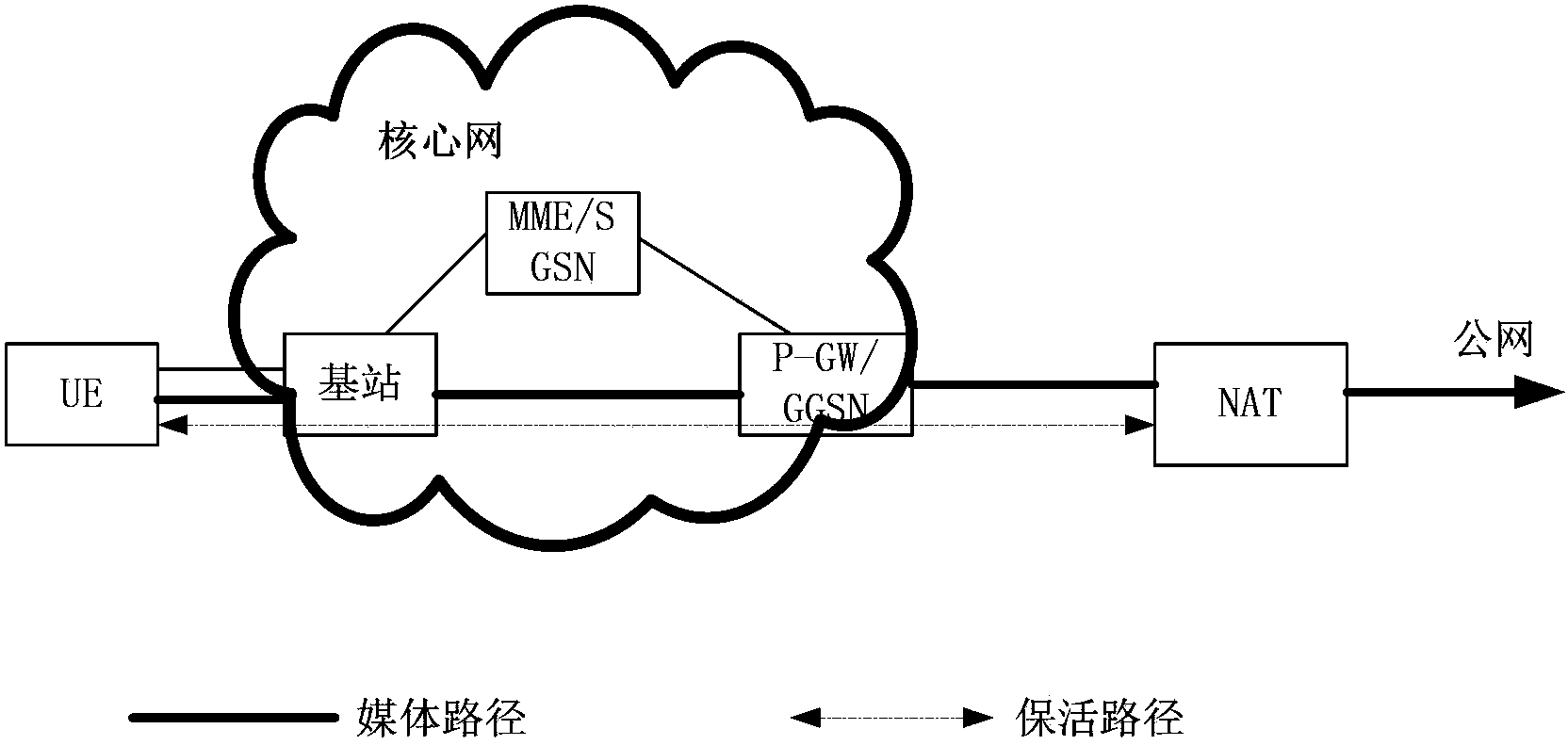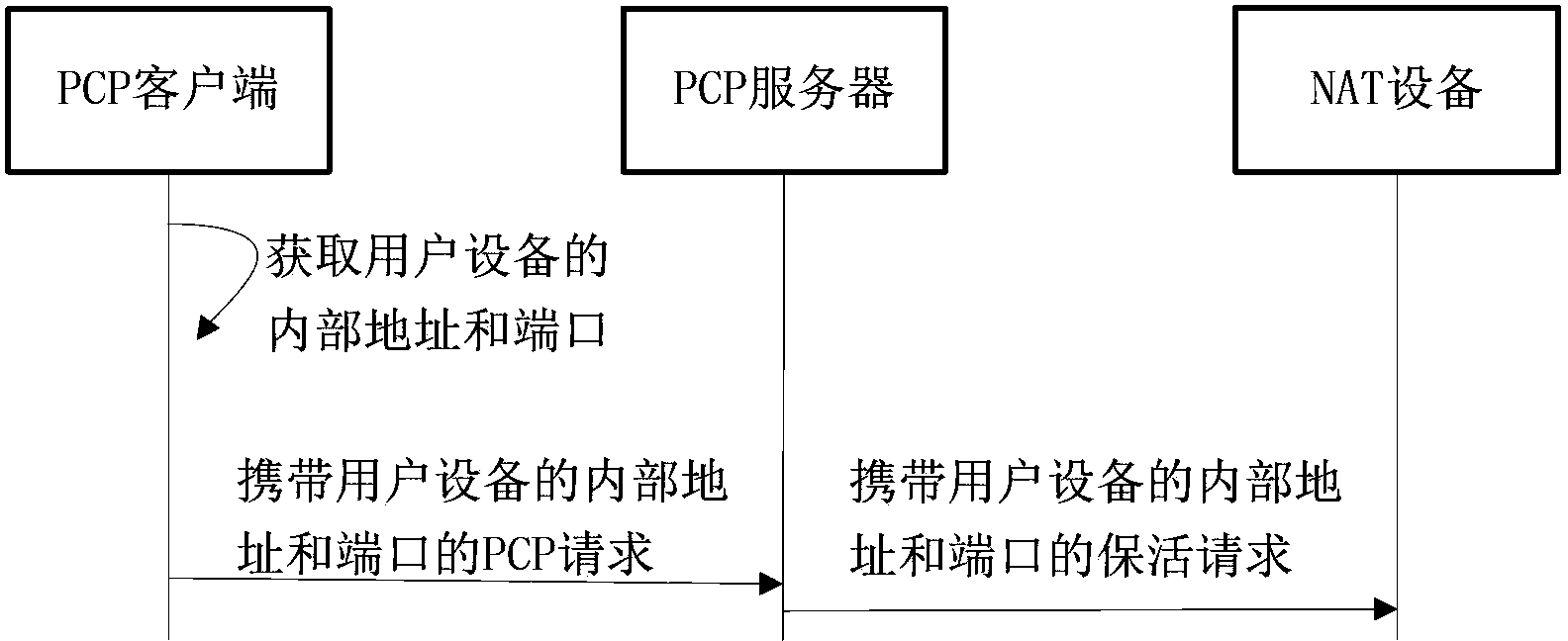Method and device for completing network address translation keep-alive by adopting port control protocol
A port control protocol and network address translation technology, applied in network data management, power management, electrical components, etc., can solve the problems of increasing air interface burden, large wireless communication, and consuming user equipment battery life
- Summary
- Abstract
- Description
- Claims
- Application Information
AI Technical Summary
Problems solved by technology
Method used
Image
Examples
Embodiment 1
[0101] In the first embodiment, the public data network gateway serves as the PCP client and the PCP server to jointly complete the NAT keep-alive. In this embodiment, the P-GW / GGSN is used as the specific network element of the public data network gateway, and the MME / SGSN is used as the specific network element of the control network element. like image 3 As shown, the P-GW or GGSN judges that it needs to perform NAT keep-alive instead of the UE, and the P-GW or GGSN sends a PCP request to the PCP Server, carrying the private network IP address and port of the UE that needs to keep alive. The PCP server periodically sends a keep-alive message to the NAT instead of the UE. Including four implementations.
[0102] Implementation method one
[0103] In the first implementation, the UE sends the internal address and port of the UE to the P-GW / GGSN through the MME / SGSN of the core network, and the P-GW / GGSN receives the message from the UE through the signaling path, which co...
Embodiment 2
[0173] Figure 8 It is a schematic diagram of UE acting as a PCP client and a PCP server to jointly complete NAT keep-alive. As shown in the figure, the UE itself acts as a PCP client and sends a PCP request to the PCP server. There are two ways to route the UE's PCP request to the PCP server: in the first implementation, the UE carries the PCP request message in the PCO of the control signaling message and sends the control signaling message to the P-GW / GGSN, and the P-GW / The GGSN sends the PCP request message to the PCP server; in the second implementation, the UE learns the address of the P-GW / GGSN, sends the PCP request to the P-GW / GGSN, and then the P-GW / GGSN queries and selects a PCP server , routing the PCP request sent by the UE to the PCP server.
[0174] Implementation method one
[0175] The UE carries the PCP request message in the PCO of the control signaling message, and sends the control signaling message carrying the UE's internal address and port to the P-G...
Embodiment 3
[0226] like Figure 11 As shown, when the application server (AF) as the PCP client determines that the UE needs to perform NAT keep-alive, it sends a PCP request carrying the internal address and port of the UE to the Policy and Charging Rules Function (PCRF), and the PCRF sends the PCP request to PCP server. After receiving the PCP request, the PCRF performs the function of PCP Proxy, forwards the PCP request to the PCP server, and the PCP server sends the keep-alive message to the NAT instead of the UE.
[0227] It should be noted that the AF obtains the internal IP and port of the UE, which may be reported by the UE when the UE registers with the network where the AF is located, or obtained by the AF from the P-GW / GGSN through the PCRF query.
[0228] like Figure 12 As shown, the method includes steps 1200 to 1216:
[0229] Step 1200: The UE attaches to the 3GPP network and connects to the core network control network element MME / SGSN serving it. The MME / SGSN selects ...
PUM
 Login to View More
Login to View More Abstract
Description
Claims
Application Information
 Login to View More
Login to View More - R&D
- Intellectual Property
- Life Sciences
- Materials
- Tech Scout
- Unparalleled Data Quality
- Higher Quality Content
- 60% Fewer Hallucinations
Browse by: Latest US Patents, China's latest patents, Technical Efficacy Thesaurus, Application Domain, Technology Topic, Popular Technical Reports.
© 2025 PatSnap. All rights reserved.Legal|Privacy policy|Modern Slavery Act Transparency Statement|Sitemap|About US| Contact US: help@patsnap.com



